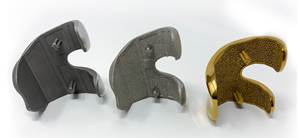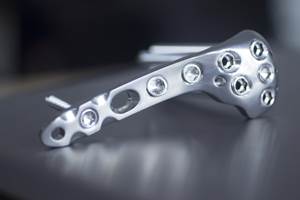Under One Roof
In bringing multiple manufacturing processes in-house, this medical shop parallels its customers' efforts to be one-stop sources for hospital equipment.
Success comes to shops that are attentive to the changing needs of their customers. Such shops are generally willing to make fundamental manufacturing changes and process additions, when appropriate, to best meet those demands. In a growing number of cases, a shop’s customer wants to receive more than just a component that has been accurately machined. This is clearly evident in the medical industry, in which medical equipment OEMs would prefer to cut a purchase order for a solution, rather than simply a machined part.
Fairborn, Ohio’s DEW Technologies is a shop that has noticed this trend. Kenneth Ross, director of business management, notes that many large medical OEMs are purchasing smaller companies for an expanded range of product offerings. That way, an OEM that offers implant devices, for example, can also be a source for all other miscellaneous equipment that hospitals use every day.
Mirroring this single-source trend, DEW Technologies has brought a number of formerly outsourced post-machining processes in-house. The shop has added capacity over the years to perform precision parts machining and nearly every secondary operation that a medical component may require: passivation, laser etching, anodizing and specialized cleaning, in addition to assembly and packaging. This not only streamlines its customers’ supply chain and helps speed time to market for their new products, but also offers DEW Technologies better control over cost, quality and delivery times.
Machining Comes First
DEW Technologies specializes in manufacturing spinal and trauma components, 80 percent of which are produced from titanium. These components must start with accurate machining, because tolerances for some features can be as tight as ±0.0002 inch. Because many of these components have contoured geometries, five-axis machining is not only desired, it’s mandatory. The shop has a number of five-axis VMCs from OKK (Glendale Heights, Illinois), in addition to VMCs with indexing tables from Haas Automation (Oxnard, California). All of these machines offer true five-axis machining as well as workpiece positioning in five axes. They also all include probes from Renishaw (Hoffman Estates, Illinois) and workholding pallet systems from System 3R (Totowa, New Jersey) for quicker setups and repeatable workpiece positioning.
The company also has Swiss-style lathes from Star CNC (Roslyn Heights, New York) used primarily to produce screws and other threaded components. Each is fitted with a bar feeder to allow long stretches of unattended operation. Two Swiss-style lathes are part of a work cell that also includes two Haas VMCs. The lathes produce screws that are used with plates milled on the VMCs.
Two pneumatic bending devices the shop designed are also found in that cell. While the VMCs are running other plate jobs, an operator can bend a machined plate by locking it in the device’s fixture and having it slowly bend the plate to the desired angle. A threaded stop is adjustable to allow the plate to be bent to the angle required for the application. The plates and equipment are shown on pages 72 and 73.
The shop also has ram and wire EDM equipment from Mitsubishi EDM (Wood Dale, Illinois). Although these machines are not used to run as many part numbers as the HMCs, VMCs and Swiss-style lathes, they are often the only means to produce some of the shop’s most complex parts.
Got PEEK?
Although 80 percent of the components DEW Technologies currently machines are produced from titanium, that high percentage might soon drop. That’s because the use of PEEK thermoplastic polymer for medical implant devices is rising, as are the number of PEEK components the shop is processing.
PEEK is short for—take a deep breath— polyetheretherketone. One advantage to this material is that it does not appear on an X-ray. How is this helpful? In cases where spinal disks must be fused together, machined PEEK spacers are often used. The hollow center of a spacer is typically packed with bone chips. Once inserted between disks, the bones fuse together through and around the spacer. Spacer invisibility on an X-ray provides the doctor with an unobstructed view the bone healing process. This would not be possible with spacers made from titanium or stainless steel.
The shop began working with the material about two years ago, and these spacers are the most common PEEK component machined there. DEW Technologies machines this material using carbide tools from SGS Tool Co. (Munroe Falls, Ohio) that are specifically designed to machine plastics. The material is machined dry, using air blast for chip control. Its machineability is said to be similar to that of Delrin. A two-pallet OKK HMC uses tombstones to allow machining of multiple parts in one setup.
This implant-grade PEEK material differs from industrial PEEK in various ways. One big difference is the price. A 1-meter-long rod of implant-grade PEEK can cost thousands of dollars, which means imprecise machining and scrapping workpieces is simply not an option. Also, all equipment used to process PEEK must be dedicated to running only that material to avoid any chance of contamination (signs on some shop equipment serve as a reminder). The reason for dedicating equipment Similarly, operators and assemblers must wear gloves when handling this material to keep oils and residue off the parts. DEW Technologies is one of just a few shops that offers a special FDA-approved PEEK cleaning system that is required after machining. Having this process in-house is definitely an attraction to potential customers.
Primary Consideration Of Secondary Operations
Of the post-machining processes the shop has added over the years, Mr. Ross notes that the shop has achieved the highest time and cost savings by adding titanium anodizing capability. The shop’s custom, automated anodizing system offers both Type II and Type III anodizing. Type II hard coating offers increased wear resistance and lubricity; Type III is generally more for aesthetics and to achieve a particular color for part identification. In many instances, the color of a screw or other component corresponds to its size.
The shop decided to install an automated system to allow unattended operation and precise timing of the workpieces as they are dipped in the system’s various different chemical baths. There was a big learning curve in integrating this technology, and the shop hired a chemical engineer for system programming.
Keeping with its creative drive, the shop designed its own rack-loading system to ease the operator’s job, because loaded racks can weigh as much as 30 pounds. It also developed a proprietary part-racking mechanism to secure the numerous parts during the anodizing process. The rack is designed to allow threaded workpieces, for example, to be secured on two small contact points on a thread, so there are essentially no visible rack marks even under high-power magnification.
Other non-machining operations that the shop has added over the years include:
- Laser etching—The medical industry requires that a shop be a stickler for traceability from barstock through bagged component. That means some sort of marking technology is needed. DEW Technologies has had laser etching capability for some time, and currently has two etching machines. Laser etching permanently marks material without inks or chemicals that could potentially contaminate a component. The type of information required on a part may include company logo, serial number, bar code, and date and shift code.
- Passivation—The shop has offered passivation for titanium workpieces for some time. The passivation system is located near the anodizing equipment to allow both processes to share the required fume ventilation system. Passivation is necessary to remove any metallic contaminants from the surface of the material and to ensure a uniform, protective oxide layer after machining.
- Assembly—The 10-piece assembly shown on page 77 is a prime example of how all of DEW Technologies’ various manufacturing capabilities come together to deliver a solution for a customer. Nearly every aspect of its in-house processes are used to produce the components that make up the assembly, including milling, turning, EDM, passivation, anodizing (both Type II and III) and assembly.
Admittedly, there is one process that the shop currently outsources for this assembly—laser welding. The reason it is not performed in-house is because of the steep learning curve coupled with the fact that the shop has a vendor that has been very reliable for this tricky joining process. That said, laser welding capability will be added at some point.
- Packaging—Part handling and packaging is a nightmare when outsourcing secondary operations. Consider the number times a part is “touched” when anodizing is outsourced. After machining, each component would be packaged, sent to the anodizer, anodized, repackaged in individual bags, delivered back to the shop, opened, inspected, and then assembled and/or re-packaged for delivery to the customer.
To help alleviate such handling headaches, the shop added an automated bagging machine just over a year ago. The machine marks any barcode, logo or other information the customer requires on the part’s bag. It then drops the part in the bag and hot-seals the bag. Not only does this automated bagging capability provide huge time savings, it also reduces cost in terms of the number of printer cartridges the shop quickly went through for stick-on labels.
Related Content
4 Ways 3D Printing Is Changing Medical Implants
Additive manufacturing provides new ways of making medical implants, but its impact is greater than this. How 3D printing is changing medical manufacturing and improving patient outcomes.
Read MoreBest Practices: Machining Difficult Materials
Cutting hardened steel, titanium and other difficult materials requires picking the right tools, eliminating spindle runout and relying on best practices to achieve tight part tolerances.
Read MoreKyzen Solvents Provide Ease of Cleaning for Medical Parts
The Metalnox line of solvent products are designed to improve reliability and increase the ease of cleaning in vacuum and vapor degreasing processes.
Read MoreSolidCAM Wants to Help Machine Shops Get into Additive Manufacturing
SolidCAM's partnership with Desktop Metal is aimed at making additive manufacturing more accessible to job shops and other manufacturers.
Read MoreRead Next
How To Passivate Stainless Steel Parts
You've made sure the parts were machined to spec. Now, make sure you've taken steps to protect those parts in the condition your customer expects them.
Read More3 Mistakes That Cause CNC Programs to Fail
Despite enhancements to manufacturing technology, there are still issues today that can cause programs to fail. These failures can cause lost time, scrapped parts, damaged machines and even injured operators.
Read More
.jpg;width=70;height=70;mode=crop)
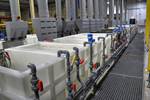



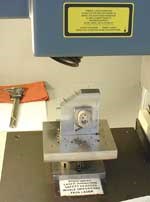


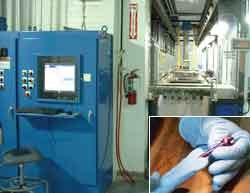






.png;maxWidth=300;quality=90)










.png;maxWidth=300;quality=90)
